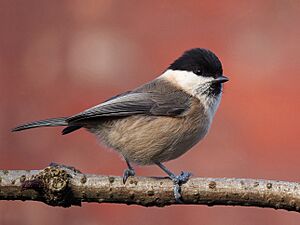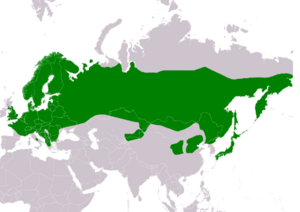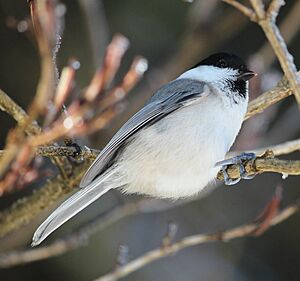Willow tit facts for kids
Quick facts for kids Willow tit |
|
|---|---|
 |
|
| Subspecies kleinschmidti, Wigan, England | |
| Conservation status | |
| Scientific classification | |
| Genus: |
Poecile
|
| Species: |
montanus
|
 |
|
| Range of Poecile montanus Resident | |
| Synonyms | |
|
Parus montanus |
|
The willow tit (Poecile montanus) is a small passerine or songbird. It belongs to the tit family, Paridae. This bird is very common and lives in many parts of Europe and Asia, especially in cooler, northern areas.
The willow tit has grey-brown and off-white feathers. It has a black cap on its head and a black patch under its chin. It prefers forests with cone-bearing trees (like pine and spruce) more than its close relative, the marsh tit. This is why you can find it further north. Most willow tits stay in the same area all year and do not travel to warmer places for winter.
Contents
About the Willow Tit
Naming the Willow Tit
A Swiss scientist named Thomas Conrad von Baldenstein first described the willow tit in 1827. He gave it the scientific name Parus cinereus montanus. The word montanus is Latin for "of the mountains," which makes sense because it was found in mountain forests.
Later, the willow tit was placed in a different group called Poecile. This group was named by a German scientist, Johann Jakob Kaup, in 1829. Scientists use DNA studies to understand how birds are related. These studies show that the Poecile group is different from the Parus group. The willow tit is also closely related to the Caspian tit.
There are 14 different types, or subspecies, of the willow tit. These different types live in various parts of the world. For example, P. m. kleinschmidti lives in Britain, while P. m. restrictus lives in Japan.
What Does a Willow Tit Look Like?
The willow tit is about 11.5 centimeters (4.5 inches) long. Its wings can spread out to about 17 to 20.5 centimeters (6.7 to 8.1 inches). It weighs around 11 grams (0.4 ounces), which is about the weight of a few paper clips.
It has a large head and a thin beak. It has a dull black cap that goes down its back and a black patch under its chin. The sides of its face are white. Its back is grey-brown, and its belly is a light yellowish-brown. Male and female willow tits look very similar.
It can be tricky to tell the willow tit apart from the marsh tit. The willow tit has a duller, sooty brown cap, while the marsh tit's cap is shinier and more blue-black. The willow tit also has more buff-colored feathers on its belly and reddish-brown sides. You might also notice a light patch on its folded wing from pale feather edges.
The most common sound the willow tit makes is a nasal "zee, zee, zee." However, their calls can change quite a bit. Sometimes, they repeat a double note, "ipsee, ipsee," several times.
Willow Tit Life Cycle
Nesting and Eggs
The willow tit is special because it digs its own nesting hole. It can even dig into hard wood! It usually chooses a rotten tree stump or a decayed part of a tree. Most nests are shaped like a cup and are made from soft materials. These can include fur, hair, and wood chips. Sometimes, they use feathers too.
The female willow tit lays one egg each day. A typical nest will have between six and nine eggs. The eggs are white with red-brown speckles and spots. These spots are often thicker at the wider end of the egg. Each egg is about 15.8 by 12.3 millimeters (0.62 by 0.48 inches) and weighs about 1.2 grams (0.04 ounces).
Only the female bird sits on the eggs to keep them warm. This is called incubation. The eggs hatch after 13 to 15 days. Once the chicks hatch, both parents help care for them and bring them food. However, only the female continues to keep the young warm. The baby birds leave the nest after 17 to 20 days. Willow tits usually only raise one group of chicks each year.
Lifespan
Scientists study birds by putting small rings on their legs. This helps them track how long birds live. In northern Finland, young willow tits have about a 58% chance of surviving their first year. After that, adult birds have about a 64% chance of surviving each year. This means that a typical willow tit that survives its first year usually lives for about three years. The oldest willow tit ever recorded lived for 11 years! One was found in Finland, and another near Nottingham, England.
What Do Willow Tits Eat?
Willow tits eat insects, caterpillars, and seeds, just like many other tit birds. They help control insect populations in their habitats.
Willow Tit Population Status
The willow tit lives across a very large area. Scientists believe there are between 175 and 253 million adult willow tits in the world. While this number is very large, the population seems to be slowly getting smaller. However, the decline is not happening fast enough to be a major concern globally. Because of this, the International Union for Conservation of Nature lists the willow tit as a species of "least concern."
However, in some places, like the United Kingdom, the situation is different. The number of willow tits in the UK dropped by 83% between 1995 and 2017. Their living areas also became smaller. Scientists think this rapid decline is due to three main reasons:
- Habitat loss: Their homes are disappearing.
- Competition for nests: Other tit birds, especially blue tits, compete for the best nesting holes.
- Nest predation: Great spotted woodpeckers are eating their eggs and chicks. The number of great spotted woodpeckers has grown a lot in the same time period.





